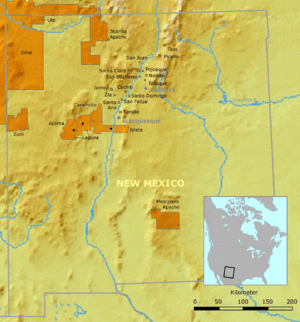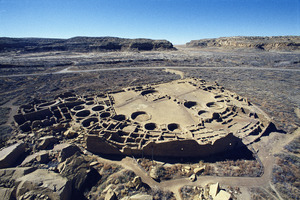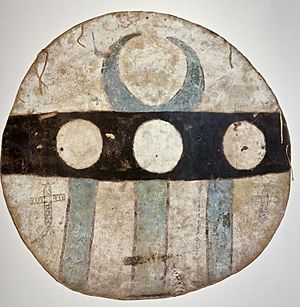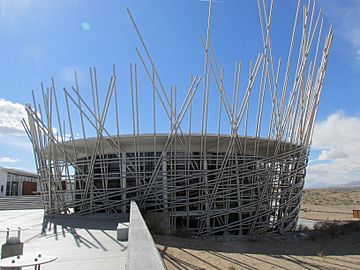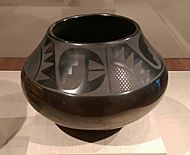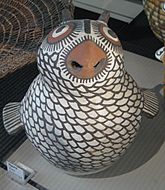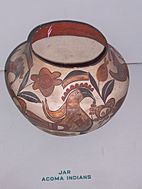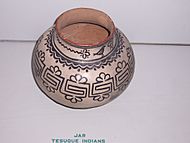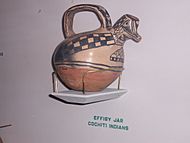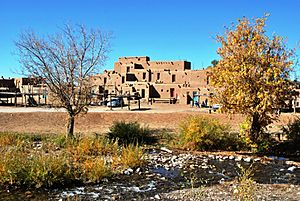Puebloans facts for kids
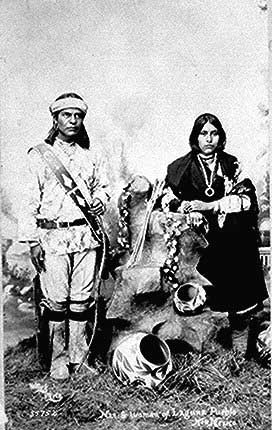
Laguna Pueblo dwellers
|
|
| Total population | |
|---|---|
| c. 75,000 | |
| Regions with significant populations | |
| US c. 75,000 | |
| Particularly: New Mexico and Arizona | |
| Languages | |
| Spanish (NM, US), English (NM, US), Indigenous languages of New Mexico (Jemez, Jicarilla, Keresan, Keresan Pueblo Sign Language, Picuris, Southern Tiwa, Taos, Tewa, Zuni) | |
| Religion | |
| Christianity (Predominantly Roman Catholic, Protestant) | |
| Related ethnic groups | |
| Hispanos of New Mexico (Mestizos) As well as other indigenous peoples of the North American Southwest (Southwestern United States): Navajo, Apache, Comanche, Ute Peoples |
The Puebloans or Pueblo peoples are Native Americans who live in the Southwestern United States. They share similar ways of farming, building, and practicing their religion. The word "Pueblo" means "village" in Spanish. The Spanish used this term because of the unique village-style homes these people built.
When Spanish explorers arrived in the 1500s, they found amazing, multi-story villages. These homes were made from adobe (a type of mud brick), stone, and other local materials. Most Pueblo communities today are in New Mexico. Some are also in Arizona and Texas. They are often found near the Sangre de Cristo Mountains and along the Rio Grande and Colorado rivers.
Today, about 100 Pueblo villages are still lived in. Some of the most famous include Taos, San Ildefonso, Acoma, Zuni, and Hopi. You might hear the word Anasazi used for ancient Pueblo people. However, this word comes from the Navajo and means "Ancient Ones" or "Ancient Enemy." Because of this, many Pueblo people prefer not to use it.
Puebloans speak languages from four different language families. This means their languages are very different from each other. Even so, all Pueblo groups grow different kinds of corn.
Pueblo nations have kept many of their old traditions alive. These traditions focus on farming, strong family groups (called clans), and respecting their history. Puebloans have been very good at keeping their culture and religious beliefs. They have even blended some of their beliefs with Catholicism. We don't know the exact number of Pueblo people today. But in the 21st century, about 35,000 Pueblo people are thought to live in New Mexico and Arizona.
Contents
Different Pueblo Groups
Even though Pueblo peoples share many cultural and religious practices, they also have differences. Experts often divide them into smaller groups based on their languages and unique traditions.
Languages They Speak
The clearest way to divide Puebloans is by the languages they speak. Pueblo peoples speak languages from four different language families. This means their languages have completely different words and grammar. Because of this, people from one Pueblo often cannot understand people from another. English is now often used as a common language in the region.
- Keresan: This family includes Western and Eastern Keres. Some people think it's a language isolate, meaning it's not related to other language families. It's spoken in pueblos like Acoma, Laguna, Santa Ana, Zia, Cochiti, Kewa, and San Felipe.
- Kiowa-Tanoan: This group includes the Tanoan branch, which has three parts:
- Towa: Only spoken at Jemez Pueblo.
- Tewa: The most common Tanoan language. It has several dialects and is spoken at Ohkay Owingeh, San Ildefonso, Santa Clara, Tesuque, Nambé, and Pojoaque Pueblos.
- Tiwa: This part has separate languages:
- Northern Tiwa: Has two dialects, spoken at Taos and Picuris.
- Southern Tiwa: Also has two dialects, spoken at Sandia and Isleta Pueblos.
- Uto-Aztecan: This group includes Hopi, spoken only at Hopi Pueblo.
- Zuni: This is a language isolate, meaning it's not related to other language families. It's spoken only at Zuni Pueblo.
Cultural Traditions
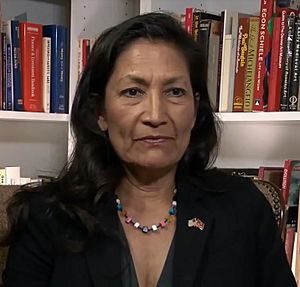
Experts have studied Pueblo peoples a lot. They have found differences in their cultural practices. For example, some Pueblos, like the Zuni and Hopi, are known as Western or Desert Pueblos. They specialize in dry farming, which means growing crops without much water. Eastern or River Pueblos, on the other hand, use irrigation to water their crops. Both groups mostly grow corn, but squash and beans are also important foods.
In some Pueblo groups, like the Hopi and Zuni, children belong to their mother's family group (clan). They must marry someone from a different clan. These groups also have special underground rooms called kivas for sacred ceremonies. Their stories say that humans came from underground. They often focus on four or six main directions in their beliefs.
Other Pueblo groups, like most Tanoan-speaking people, have children belong to their father's clan. They often marry within their own clan. These groups usually have two kivas. Their beliefs often involve two opposing forces. Their stories say people came from underwater. They use five directions in their beliefs.
History of the Puebloans
Early Cultures
Pueblo societies developed from three main cultures that lived in the Southwest before Europeans arrived. These were the Mogollon Culture, the Hohokam Culture, and the Ancestral Puebloan Culture.
The Mogollon people were first hunter-gatherers. They later started farming more. By the 10th to 12th centuries, they used water control systems for their farms. Their homes changed over time. Early villages had small pithouses, which were houses dug into the ground. Later, they built homes with rock and earth walls. By the 13th and 14th centuries, cliff dwellings became common.
The Hohokam culture used amazing irrigation canals to water their crops as early as the 9th century CE. Their farming methods helped them become the largest population in the Southwest by 1300. Archaeologists have found evidence that people who were ancestors of the Hohokam lived in southern Arizona as early as 2000 BCE. They grew corn and lived in villages year-round.
The Ancestral Puebloan culture is famous for its stone and earth homes built along cliff walls. You can see well-preserved examples in Navajo National Monument, Chaco Culture National Historical Park, and Mesa Verde National Park. These villages were often hard to reach, sometimes only by rope or climbing. Early Ancestral Puebloan homes were also pithouses. Later, they built apartment-like buildings from stone and adobe mud. These ancient towns were often multi-story buildings around open plazas. Hundreds or even thousands of people lived in them.
How Villages and Cities Grew
Around 700 to 900 CE, Puebloans started building connected, rectangular rooms. These were like apartment buildings made of adobe. By 1050, they had planned villages with large, terraced buildings. These villages were often built in places that were easy to defend. They were on high ledges, flat hilltops, or steep-sided mesas. This helped protect them from groups like the Comanche and Navajo. The biggest of these villages was Pueblo Bonito in Chaco Canyon, New Mexico. It had about 700 rooms and may have housed up to 1000 people.
European Arrival and Resistance

Before 1598, only small Spanish groups explored the Pueblo areas. Then, a group of Spanish settlers led by Juan de Oñate arrived. They wanted to introduce Christianity to the Native peoples. At first, there was peace. But Spain tried harder and harder to replace the Pueblo religion with Catholicism. The Puebloans resisted this strongly. Their leaders, called caciques, were important for both daily life and spiritual matters. Over time, the Spanish became harsher, leading to several Pueblo revolts.
The Pueblo Revolt of 1680 was very important. It was the first time a Native American group successfully forced colonists out of North America for many years. This revolt happened because the Northern Pueblos were unhappy with how the Spanish treated them.
A severe drought in the 1670s made things worse. It caused hunger among the Pueblo people and led to more attacks from the Apache. Neither the Spanish nor the Pueblo soldiers could stop these attacks.
In 1675, the Spanish governor, Juan Francisco Treviño, arrested 47 Pueblo medicine men. He accused them of practicing sorcery. Four were sentenced to death. The others were publicly whipped and jailed. When Pueblo leaders heard this, they marched to Santa Fe, where the prisoners were held. The governor had to release the prisoners because many Spanish soldiers were away fighting the Apache. One of the released men was a Tewa man named Popé from Ohkay Owingeh.
After being freed, Popé went to Taos Pueblo, far from Santa Fe. For five years, he worked to get support for a revolt from 46 Pueblo villages. He gained support from many groups. On August 10, 1680, Popé and other leaders sent knotted ropes by runners to each Pueblo. The number of knots showed how many days to wait before starting the uprising. On August 21, 2,500 Pueblo warriors took control of Santa Fe from the Spanish. They killed many settlers and forced the rest to leave.
On September 22, 2005, a statue of Po'pay (Popé) was put in the Capitol Rotunda in Washington, D.C. It was made by Cliff Fragua, a Puebloan from Jemez Pueblo, New Mexico. It is the only statue in the collection made by a Native American.
Pueblo Culture
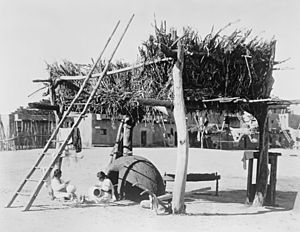
In 1844, a traveler named Josiah Gregg described the Pueblo people. He said they lived in comfortable homes and farmed the land. He noted they were the best farmers in the area, growing most of the fruits and vegetables. They also raised cattle and horses. He called them "sober and industrious," known for being moral and honest, and not often quarreling.
Daily Life and Crafts
Puebloans have a long history of weaving cloth. They use natural fibers and animal hides to make clothing. Since weaving takes a lot of time and effort, everyday clothes for working were simpler. Men often wore breechcloths.
Farming and Food
Corn is the most important food for Pueblo peoples. While they might have grown local plants like gourds early on, the first proof of corn farming in the Southwest dates back to about 2100 BCE. Small, wild corn cobs have been found in New Mexico and Arizona.
Corn came to the Southwest from present-day Mexico. It was quickly adopted by the people there. One idea is that farmers from central Mexico, possibly speaking a Uto-Aztecan language, brought corn north. Another, more accepted idea, is that corn spread from group to group between 4300 BCE and 2100 BCE.
Pottery Making
Each Pueblo community has its own unique ways of making and decorating pottery. Archaeologists believe Puebloans have been using pottery since the early centuries CE.
-
San Ildefonso Pueblo Black-on-Black Pottery Bowl by Maria Martinez
-
Zuni owl figure, University of British Columbia
-
Bird effigy, pottery, Cochiti Pueblo. Field Museum
Religion and Beliefs

In the Southwest Native communities, important spiritual beings bring blessings. Their many religious stories explore how people relate to nature, including plants and animals. Spider Grandmother and kachina spirits are important in some myths.
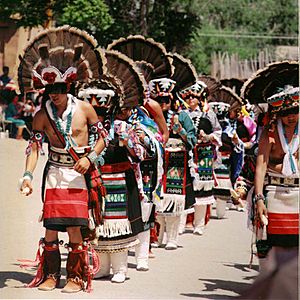
Pueblo prayers use actions and objects, not just words. Ground-up white cornmeal is a common prayer material. A person might bless their child, land, or town by sprinkling cornmeal while saying a blessing.
Pueblo peoples also use special 'prayer sticks'. These are colorful and decorated with beads, fur, and feathers. By the 13th century, Puebloans used turkey feather blankets to stay warm.
Most Pueblos have yearly sacred ceremonies. Some of these are open to the public. These ceremonies often feature traditional dances held outdoors in large common areas. They are accompanied by singing and drumming. These dances are seen as a form of prayer. There are strict rules for those who attend, like no clapping or walking through the dance area.
Traditionally, visitors to a public dance would be offered a meal in a Pueblo home afterward. Because so many tourists now attend, these meals are by personal invitation only. Private sacred ceremonies happen inside the kivas. Only tribal members can take part, following specific rules for each Pueblo's religion.
When Spanish colonists arrived in the 1600s, they wanted to bring Christianity to the Native peoples. Franciscan priests built churches and missions across Pueblo lands. Pueblo feast days are a result of this. Feast days are held on the day of a Pueblo's Roman Catholic patron saint. Spanish missionaries chose these days so they would match existing Pueblo traditional ceremonies. Alfonso Ortiz, a Pueblo expert, said that the Spanish tried to stop native religions. But the Pueblos learned to keep their ceremonies secret while seeming to adopt Catholicism.
Public feast day celebrations may also include a Roman Catholic Mass and processions. Some Pueblos also have sacred ceremonies around Christmas and other Christian holidays.
List of Pueblos
New Mexico
- Acoma Pueblo – Keres speakers. Famous for being built on top of a mesa. It was established in the 12th century and is one of the oldest places in the United States where people have lived continuously.
- Cochiti Pueblo – Keres speakers. Known for its ceramic storyteller figurines and drums.
- Isleta Pueblo – Tiwa speakers. Established in the 14th century. It's located just south of Albuquerque.
- Jemez Pueblo – Towa speakers. Known for its runners and running ceremonies.
- Kewa Pueblo (formerly Santo Domingo) – Keres speakers. Known for turquoise jewelry and the Corn Dance.
- Laguna Pueblo – Keres speakers. Known for its well-preserved 17th-century mission church.
- Nambé Pueblo – Tewa language speakers. Established in the 14th century. It was an important trading center for the Northern Pueblos.
- Ohkay Owingeh Pueblo (formerly San Juan) – Tewa speakers. This is where Popé, a leader of the 1680 Pueblo Revolt, came from.
- Picuris Pueblo – Tiwa speakers. Known for its special micaceous pottery.
- Pojoaque Pueblo – Tewa speakers. It was re-established in the 1930s.
- Sandia Pueblo – Tiwa speakers. Established in the 14th century. Located just north of Albuquerque.
- San Felipe Pueblo – Keres speakers.
- San Ildefonso Pueblo – Tewa speakers. Famous for its valuable black-on-black pottery.
- Santa Ana Pueblo – Keres speakers.
- Santa Clara Pueblo – Tewa speakers. Established in the 16th century.
- Taos Pueblo – Tiwa speakers. Known for its unique architecture. Established in the 11th century, it is one of the oldest continuously inhabited places in the United States.
- Tesuque Pueblo – Tewa speakers. Known for its role in the Pueblo Revolt of 1680 and its ceramic Rain God figurines.
- Zia Pueblo – Keres speakers. Known for their sun symbol, which is on New Mexico's state flag.
- Zuni Pueblo – Zuni speakers. Known as the first Pueblo visited by the Spanish in 1540.
Arizona
- Hopi Tribe Nevada-Kykotsmovi – Hopi language speakers. The area of their current villages was settled around 700 CE.
Texas
- Ysleta del Sur Pueblo, El Paso, Texas – Originally Tigua (Tiwa) speakers. This Pueblo was formed in 1680 after the Pueblo Revolt. Some Pueblo people were forced to move or went with the Spanish to El Paso when they fled New Mexico.
- Some of the Piro Puebloans settled in Socorro, Texas, near Ysleta. The Rio Grande river often changed its path, so these missions sometimes ended up in Mexico or Texas.
- The Texas Band of Yaqui Indians are descendants of the Yaqui people. Many of their families organized as a band in 2001 and are recognized by the state of Texas.
- Firecracker Pueblo, a Jornada Mogollon culture site, was abandoned in the 1400s. It shows how homes evolved from pit-houses to rooms with adobe walls.
Feast Days and Celebrations
Pueblo communities celebrate many feast days throughout the year. These days often combine traditional Pueblo ceremonies with Catholic feast days.
- January
- San Ildefonso Pueblo Feast Day: January 23.
- May
- San Felipe Pueblo Feast Day: May 1.
- June
- Ohkay Owingeh Pueblo Feast Day: June 24.
- Sandia Pueblo Feast Day: June 13.
- Ysleta / Isleta del Sur Pueblo Feast Day: June 13.
- July
- Cochiti Pueblo Feast Day: July 14.
- Santa Ana Pueblo Feast Day: July 26.
- August
- Picuris Pueblo Feast Day: August 10.
- Jemez Pueblo Feast Day: August 2.
- Santo Domingo Pueblo Feast Day: August 4.
- Santa Clara Pueblo Feast Day: August 12.
- Zia Pueblo Feast Day: August 15.
- September
- Acoma Pueblo Feast Day of San Esteban del Rey: September 2.
- Laguna Pueblo Feast Day: September 19.
- Taos Pueblo Feast Day: September 30.
- October
- Nambe Pueblo Feast Day of St. Francis: October 4.
- November
- Jemez Pueblo Feast Day: November 12.
- Tesuque Pueblo Feast Day of San Diego: November 12.
- December
- Pojoaque Pueblo Feast Day: December 12.
See also
 In Spanish: Indios pueblo para niños
In Spanish: Indios pueblo para niños


